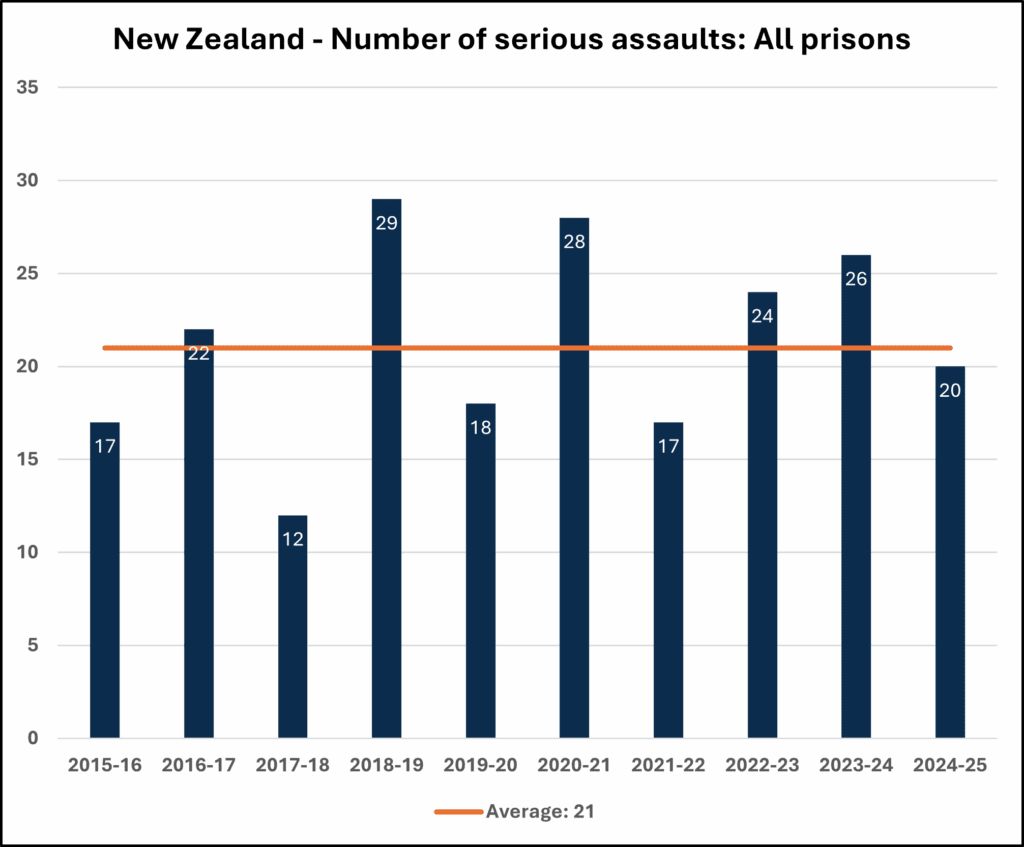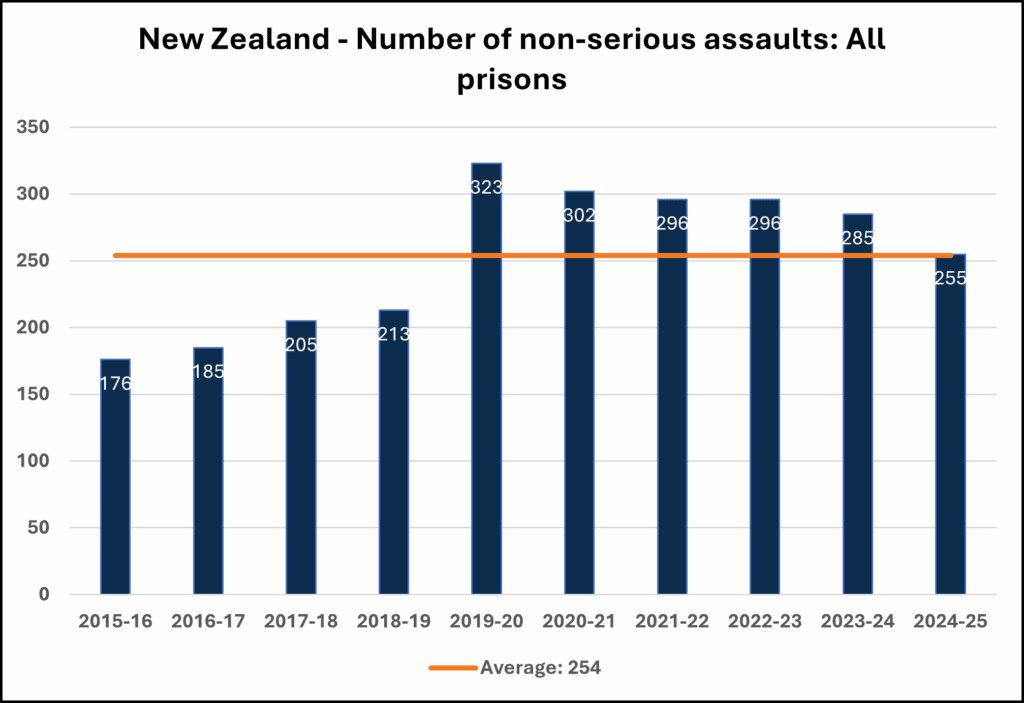Violence Against Prison Staff is Intensifying
Written by: Mike Bird
From the United States to the United Kingdom, New Zealand to South Africa, prisons are increasingly volatile environments. Fuelled by overcrowding, understaffing, gang rivalries, and deteriorating mental health conditions. The frontline staff working in these prisons, tasked with maintaining order and safety, are increasingly becoming the victims of serious attacks.
It should be noted that it’s not just the larger most populated nations that are the only ones dealing with the problems highlighted above.
Take New Zealand for example, an island country of two main landmasses, North Island and South Island, located in the southwestern Pacific Ocean and neighbours to Australia. With an estimated 2025 population of around 5.3 million and a population density of around 19.7 people per square kilometre, it’s a sparse open country.
However, data collected from the NZ Department of Corrections/Ara Poutama Aotearoa from 2015 to present, shows a fluctuating but concerning pattern of serious assaults in New Zealand prisons over the past decade. The highest recorded incidents occurred in 2018-19 with 29 serious assaults and 2020-21 with 28 serious assaults, well above the ten-year average of 21. While there was a notable decline to 17-18 incidents in years like 2015-16, 2017-18, and 2021-22.
However, the trend in recent years appears to be rising again, with 24 serious assaults in 2022-23 and 26 in 2023-24.
It should be noted that the data for 2024-25 is incomplete, and the number of 20 in the table below inevitably will rise higher.

The data paints a picture of a correctional system under ongoing strain. Assaults on prison staff are not isolated incidents, but part of a wider trend that spans across New Zealand’s prison network, from maximum security to remand facilities.
According to the New Zealand Department of Corrections:
“Assaults in prisons, whether against other prisoners and frontline staff, are unacceptable. Corrections staff come to work every day to keep New Zealanders safe. They deal with some of New Zealand’s most challenging people and do an exceptional and brave job in often very difficult circumstances.”
Source – Corrections NZ
Increased volatility has been attributed not just to overcrowding and staffing shortages, but to the changing nature of New Zealand’s prison population. As highlighted by the New Zealand Herald:
“Since then, we have safely reduced the prison population to manageable levels. But while doing that, we have continued to lock up our most violent and dangerous criminals. This has resulted in a far higher proportion of gang members in prison. Combined with a rise in prisoners experiencing more mental health and addiction issues, it has led to a more volatile environment for Corrections officers to manage.”
Source – NZ Herald
Most notable to stand out of all the 19 prison sites spread across New Zealand was Auckland Prison, it had the most serious assaults over the past decade. Auckland Prison was responsible for 21% of all serious assaults in the male prisons. It should be noted that Auckland Prison is the country’s only specialist maximum-security facility.
Serious: an act of physical violence that involves one or more of the following:
Non-serious: an act of physical violence that results in physical injuries that may require:
Non-injury: an act of physical violence that does not result in:

Non-serious assaults account for an average of 254 per year across NZ prisons.
The Mount Eden Corrections Facility and again, Auckland Prison, stand out by a fair margin of the prisons with the most non-serious assaults. With Auckland Prison having 346 over the past decade and Mt Eden Corrections Facility having a whopping 456. Mt Eden serves as the main reception prison for newly remanded male prisoners in NZ, the high figure of assaults likely reflects the hectic nature of early detention periods.
A positive to note, although very slowly, there has been a decline in non-serious assaults since 2019-20 to present, as shown in the graph above.
So, it begs the question, what should NZ Dept of Corrections do? I’m sure they’re very aware that corrections officers are not there for collateral damage. They’re performing one of the toughest jobs in the public sector and deserve the best protections that can be afforded.
Root causes that lead to problems should be addressed, like understaffing for example, in recent years it has been reported in the media that the NZ Dept of Corrections is down by more than 850 frontline staff. A lack of staff means that prison programmes, time out of cells, and visiting hours will be cut due to health and safety concerns. This in turn will lead to more stress and frustration in the prison populations, resulting in potential assaults.
Since 2015 the NZ Dept of Corrections have trialled and issued stab resistant body armour and body worn cameras. Is the body armour they have suitable and current? ‘Stab vests’ have evolved over the years and improved greatly. Super strong and light-weight options like ours that are made from a special bespoke blend of carbon fibre. These offer the wearer superb and certified all-round protection, not just from edged weapons and spikes, but from blunt force trauma attacks.
Prison leadership and policymakers, as well as the union (Corrections Association of New Zealand (CANZ)) must come together and prioritise staff safety. This means reviewing current protective equipment standards, enhancing de-escalation training, increasing staffing ratios, and ensuring robust post-incident support.
A measure of a fair and moral Department of Corrections is not only how it treats its prisoners, but also how it protects those who guard them.
Mike Bird, Director of Corporate Relations at PPSS Group
With over 35 years’ experience in custodial, security, and care settings, Mike brings extensive expertise in handling highly hostile, challenging, and complex individuals. After 20 years in the prison service, specialising in the Use of Force and serving as a National Instructor at the National Tactical Response Group (NTRG), Mike has since provided training and consultancy services to police and prison services in the UK, Africa, Asia and Europe.